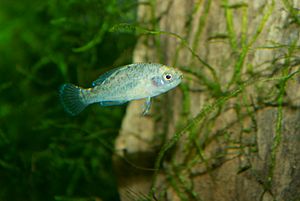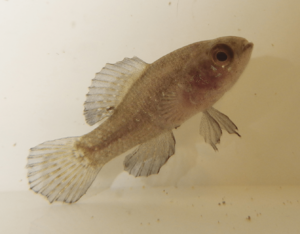Everglades pygmy sunfish facts for kids
Quick facts for kids Everglades pygmy sunfish |
|
|---|---|
 |
|
| Conservation status | |
| Scientific classification |
The Elassoma evergladei, also known as the Everglades pygmy sunfish, is a small and interesting fish. It is part of the Elassoma family, which are all called pygmy sunfishes. This special fish lives only in North America.
Contents
What Does It Look Like?
This tiny fish can grow up to about 3.4 centimeters (about 1.3 inches) long. Most of them are around 2.3 centimeters (about 0.9 inches) long. It has small scales on the top of its head. Its mouth is small and points upwards a bit. This fish does not have a "lateral line," which is a special sensing line many fish have.
Behind each of its eyes, there is a cool crescent-shaped area. This area can look gold or shiny blue. The fish also has dark lips. Female fish can carry many eggs, from 115 to 500, depending on their size.
The Everglades pygmy sunfish can change its color and shape. Usually, its body is brown with darker spots. It has rows of dark red spots on its top (dorsal) and bottom (anal) fins. Fish that are not ready to breed might have light streaks or blotches.
Female fish are often brown on their backs. Their undersides can be a mix of brown and cream or white. Some females might be reddish-brown. They usually do not have many markings. Males that are ready to breed turn black. They have shiny blue spots all over them. Their fins are black, sometimes with brown spots. Male bodies can also be black, brown, or dark green with blotches. Some males might even have shiny brassy or blue-green scales.
Where Does It Live?
The Everglades pygmy sunfish lives in the United States. You can find it from North Carolina, near the Cape Fear River, all the way to Mobile Bay in Alabama. It also lives in Florida, from the south up to the northern part of the Everglades. This fish is found more often in natural marsh areas than in man-made ones in central Florida.
This fish prefers to live in freshwater environments. It likes water with a pH level between 7.0 and 7.5. The water temperature should be between 10 and 30 degrees Celsius (50 to 86 degrees Fahrenheit). They live near the bottom in places like swamps, wet mossy areas called sphagnum bogs, and slow-moving watery channels called sloughs that have lots of plants. They also live in canals, ponds, lakes, and streams.
They usually live over soft ground like mud, silt, sand, or even old plant bits called detritus. They like areas where the water moves slowly and where water levels can change. They prefer shallow spots with lots of plants. This species tends to stick to "black water" environments more than other pygmy sunfish.
The number of these fish in an area depends a lot on the environment. But this fish is common in most places it lives. Its total population is large and stable, with an estimated 100,000 fish as of 2013.
How Does It Behave?
The Everglades pygmy sunfish usually lives by itself. It is an invertivore, which means it eats small creatures without backbones. It hunts for worms and other tiny crustaceans in its home. Its favorite foods include small water fleas, insect larvae, worms, and tiny snails.
If food is all in one spot, male fish will set up their own areas, called territories. Stronger males get territories closer to the food. But if food is spread out everywhere, males will swim freely and not claim territories.
In Captivity
When kept in aquariums, male Everglades pygmy sunfish will still create territories around feeding spots.
Reproduction and Life Cycle
Like many other fish, the Everglades pygmy sunfish is oviparous. This means the female lays eggs. A female can lay between 40 and 60 eggs at a time. The male fish will then guard these eggs to keep them safe. The eggs are usually laid on aquatic plants, especially those from the Ceratophyllum family.
Why Is This Fish Important to People?
This fish is sold in stores for people to keep in aquariums. Some people who keep fish say it is the most well-known pygmy sunfish in the hobby.
In 2013, a group called the IUCN Red List of Threatened Species said this fish was of "Least Concern." This means it is not in danger. They said this because it lives in a very large area, has many groups of fish, and its population is big and stable. There are also no major threats to it right now.
Name and History
The scientific name Elassoma comes from two Greek words. Elasson means "smaller," and soma means "body." So, it means "smaller body." The word Evergladei means "of the Everglades." This is because the first fish studied were found in the Everglades.
David Starr Jordan was the first person to describe this fish in 1884. The fish he first studied were about one inch long. In 1918, a publication called this fish the "southern pygmy sunfish."



